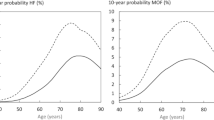Abstract
Summary
The Ecuadorian hospital discharge system examined trends in hip fracture hospitalization rates among older adults. A significant upward trend in hip fracture rates occurred in both genders over the study period.
Introduction
Previous research has reported increasing hip fracture rates in Ecuador. Thus, this study aimed to extend previous findings by examining the nationwide incidence of hip fractures among adults aged 65 years and older between 1999 and 2016. A secondary objective was to compare hip fracture trends among older Ecuadorians with their counterparts in the United States (U.S.).
Methods
The National Hospital Discharge System and the Healthcare Cost and Utilization Project net were assessed to identify older adults hospitalized with a principal diagnosis of hip fractures in Ecuador and the U.S., respectively. The Joinpoint regression analysis software was used to examine the average annual percent change in hip fracture rates.
Results
A total of 20,091 adults with a mean age of 82.3 (SD 8.1) years were hospitalized with a principal diagnosis of hip fractures during the study period. After an adjustment for age, hip fracture rates increased annually on average by 4.6% (95% CI 3.8%, 5.4%) from 96.4/100,000 in 1999 to 173.1/100,000 persons in 2016. Between 1999 and 2014, hip fracture age-adjusted rates decreased on average by − 2.5% (95% CI − 2.7%, − 2.3%) among older adults in the U.S. while hip fracture rates steadily increased by 4.6% (95% CI, 3.6%, 5.7%) per year in their Ecuadorian counterparts.
Conclusions
Hip fracture rates markedly increased among older adults in Ecuador. The present findings should alert public health authorities to implement policies of osteoporosis awareness and prevention in Ecuador.



Similar content being viewed by others
References
Cummings SR, Melton LJ (2002) Epidemiology and outcomes of osteoporotic fractures. Lancet 359(9319):1761–1767. https://doi.org/10.1016/S0140-6736(02)08657-9
Burge R, Dawson-Hughes B, Solomon DH, Wong JB, King A, Tosteson A (2007) Incidence and economic burden of osteoporosis-related fractures in the United States, 2005–2025. J Bone Miner Res 22(3):465–475. https://doi.org/10.1359/jbmr.061113
Bliuc D, Nguyen ND, Milch VE, Nguyen TV, Eisman JA, Center JR (2009) Mortality risk associated with low-trauma osteoporotic fracture and subsequent fracture in men and women. JAMA 301(5):513–521. https://doi.org/10.1001/jama.2009.50
Kanis JA, Odén A, McCloskey EV, Johansson H, Wahl DA, Cooper C (2012) IOF Working Group on Epidemiology and Quality of Life. A systematic review of hip fracture incidence and probability of fracture worldwide. Osteoporos Int 9:2239–2256
Orces CH (2009) Epidemiology of hip fractures in Ecuador. Rev Panam Salud Publica 25(5):438–442
Orces CH (2011) Trends in hip fracture rates in Ecuador and projections for the future. Rev Panam Salud Publica 29(1):27–31
Brauer CA, Coca-Perraillon M, Cutler DM, Rosen AB (2009) Incidence and mortality of hip fractures in the United States. JAMA 302(14):1573–1579. https://doi.org/10.1001/jama.2009.1462
Leslie WD, O'Donnell S, Jean S, Lagacé C, Walsh P, Bancej C, Morin S, Hanley DA, Papaioannou A, Osteoporosis Surveillance Expert Working Group (2009) Trends in hip fracture rates in Canada. JAMA 302(8):883–889. https://doi.org/10.1001/jama.2009.1231
Ballane G, Cauley JA, Luckey MM, Fuleihan G-H (2014) Secular trends in hip fractures worldwide: opposing trends East versus West. J Bone Miner Res 29(8):1745–1755. https://doi.org/10.1002/jbmr.2218
Johansson H, Clark P, Carlos F, Oden A, McCloskey EV, Kanis JA (2011) Increasing age- and sex-specific rates of hip fracture in Mexico: a survey of the Mexican Institute of Social Security. Osteoporos Int 22(8):2359–2364. https://doi.org/10.1007/s00198-010-1475-z
Jaller-Raad JJ, Jaller-Char JJ, Lechuga-Ortiz JA, Navarro-Lechuga E, Johansson H, Kanis JA (2013) Incidence of hip fracture in Barranquilla, Colombia, and the development of a Colombian FRAX model. Calcif Tissue Int 93(1):15–22. https://doi.org/10.1007/s00223-013-9717-7
http://www.eclac.cl/celade/proyecciones/basedatos_BD.htm.Accessed 1 June2017
Orces CH (2013) Prevalence and determinants of falls among older adults in Ecuador: an analysis of the SABE I survey. Curr Gerontol Geriatr Res 2013:1–7. https://doi.org/10.1155/2013/495468
Orces CH (2015) Vitamin D status among older adults residing in the littoral and Andes Mountains in Ecuador. ScientificWorldJournal 2015:1–8. https://doi.org/10.1155/2015/545297
http://www.ecuadorencifras.gob.ec/camas-y-egresos-hospitalarios/. Accessed 2 May 2017
http://apps.who.int/classifications/icd10/browse/2015/en.Accessed June 1, May 2017
http://www.cepal.org/celade/publica/bol66/BD66.html.Accessed 1 June2017
http://sni.gob.ec/proyecciones-y-estudios-demograficos Accessed 27 Oct 2017
https://hcupnet.ahrq.gov/#setup Accessed 1 June2017
https://wonder.cdc.gov/bridged-race-population.html. Accessed 1 June2017
http://surveillance.cancer.gov/joinpoint/.Accessed 1 June2017
Clegg LX, Hankey BF, Tiwari R, Feuer EJ, Edwards BK (2009) Estimating average annual per cent change in trend analysis. Stat Med 28(29):3670–3682. https://doi.org/10.1002/sim.3733
Xia WB, He SL, Xu L, Liu AM, Jiang Y, Li M, Wang O, Xing XP, Sun Y, Cummings SR (2012) Rapidly increasing rates of hip fracture in Beijing, China. J Bone Miner Res 27(1):125–129. https://doi.org/10.1002/jbmr.519
LewieckiEM, CurtisJ, GagelR, SirisE, WrightNC, YunH (2016). Hip fracture and declining DXA testing: at a breaking point. J Bone Miner Res 31 (Suppl 1) Available at http://www.asbmr.org/education/2016-abstracts. Accessed 22 Oct 2017
Betancourt Ortiz SL (2014) Bone mineral density, dietary calcium and risk factor for presumptive osteoporosis in Ecuadorian aged women. Nutr Hosp 30(2):372–384. https://doi.org/10.3305/nh.2014.30.2.7563
Wright NC, Looker AC, Saag KG, Curtis JR, Delzell ES, Randall S, Dawson-Hughes B (2014) The recent prevalence of osteoporosis and low bone mass in the United States based on bone mineral density at the femoral neck or lumbar spine. J Bone Miner Res 29(11):2520–2526. https://doi.org/10.1002/jbmr.2269
https://www.iofbonehealth.org/sites/default/files/media/PDFs/Regional%20Audits/2012-Latin_America_Audit_0_0.pdf. 1 Accessed June 2017
https://www.sheffield.ac.uk/FRAX/tool.aspx?country=43. Accessed 1 June 2017
Orces CH (2013) Emergency department visits for fall-related fractures among older adults in the USA: a retrospective cross-sectional analysis of the National Electronic Injury Surveillance System All Injury Program, 2001–2008. BMJ Open 3(1):e001722. https://doi.org/10.1136/bmjopen-2012-001722
Orces CH (2014) Prevalence and determinants of fall-related injuries among older adults in Ecuador. Curr Gerontol Geriatr Res 2014:1–7. https://doi.org/10.1155/2014/863473
Author information
Authors and Affiliations
Corresponding author
Ethics declarations
Conflicts of interest
None.
Rights and permissions
About this article
Cite this article
Orces, C.H., Gavilanez, E.L. Increasing hip fracture rates among older adults in Ecuador: analysis of the National Hospital Discharge System, 1999–2016. Arch Osteoporos 12, 109 (2017). https://doi.org/10.1007/s11657-017-0410-8
Received:
Accepted:
Published:
DOI: https://doi.org/10.1007/s11657-017-0410-8




